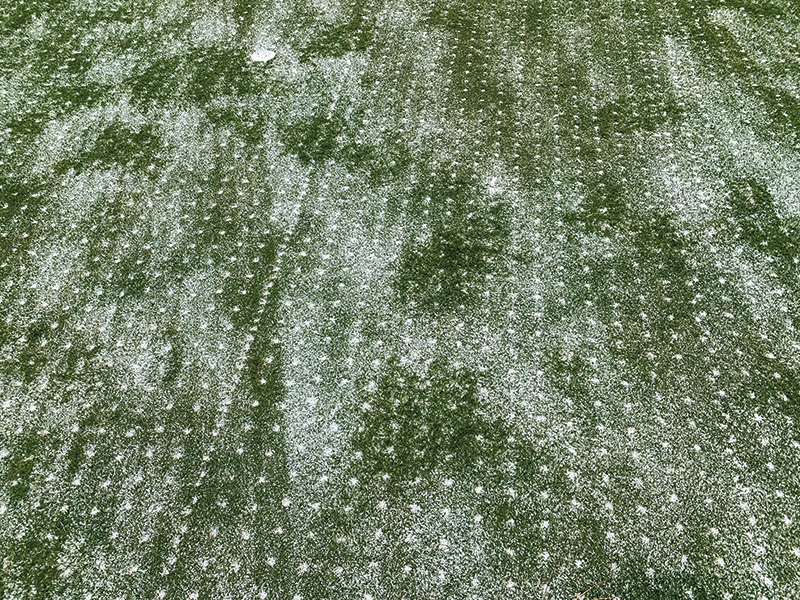
Putting green with numerous patches of collar grass that were initially distributed during aerification. Photos by John Rowland
Bermudagrass putting greens are often renovated when contamination from grasses other than those that were planted (that is, “off-types”) create an unaesthetic look or reduce playability. The source of contamination typically comes from the collar, sprigs or sod, genetic mutations (Reasor, 2019), and remnant grass. Selective methods for removal of these unwanted off-types are currently limited and only marginally effective, while nonselective removal methods are labor intensive and ultimately unsustainable. A truly selective treatment is now being used to remove faster growing off-types from bermudagrass putting greens.
Managing encroachment from the collars can be difficult, and golf course designers are still looking for an interface that does not require putting green perimeters to be refurbished every few years. Extending the same greens grass into the collars appears to be the most logical solution, especially if tighter lies are desired around the green. Although you would need to treat collars in a similar fashion to the greens and should extend the greens mix out to reduce soil moisture differences, the extended buffer would lengthen the time between renovations and allow regular mechanical edging off the actual putting surface. Seashore paspalum collars can also be used in warm-season scenarios, and the grass will typically creep over bermudagrass greens in the southern states, but they can be edged nicely with selective herbicides (e.g., Revolver), although some players do not like the sticky characteristics of the species. The newer, finer-leaved zoysiagrasses may also be worth a try since they are typically slower growers, and if bermudagrass creeps into the collars, it could be selectively edged with Recognition plus Fusilade. All these collar grass options allow for a range of mowing heights, and there are multiple cultivars of each species that can be mowed at or near greens height.
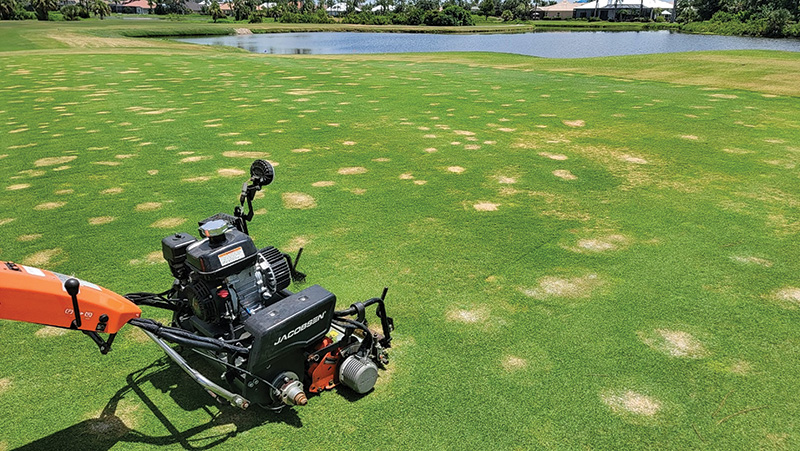
Numerous treated patches on a 5-year-old putting green.
Greens can become contaminated by performing cultural practices like core aeration and verticutting if the machines are mistakenly dropped into the collar before entering the green. Entire putting greens can become contaminated from patches that are spread with subsequent cultural disruptions and changing of cups. This can greatly impact putting green quality because of the different growth habit of the collar grass and its inability to tolerate lower mowing heights. Performing a perimeter pass first when cultivating greens can help reduce operator error since they would not have to go to the edge of the green on each pass.
Patches of unwanted grasses sometimes pop up out of nowhere from the spread of seed or vegetative plant parts. For example, seashore paspalum can often be found all over a golf course after being planted in just one test location. Contaminants can also be brought in with sprigs or sod, and noticeable patches can show up in the greens within the first couple of years. Mutations that originate from the base grass can take longer to become apparent and may have a similar growth habit when compared to its parent. They may also have a denser canopy and finer leaves, or wider leaves and a spongy surface. The finer-textured off-types are sometimes propagated further to determine if they can be marketed as new putting green varieties (Brosnan and Reasor, 2018), while the larger bladed grasses often create aesthetic and playability issues that require additional inputs (Reasor, 2019).
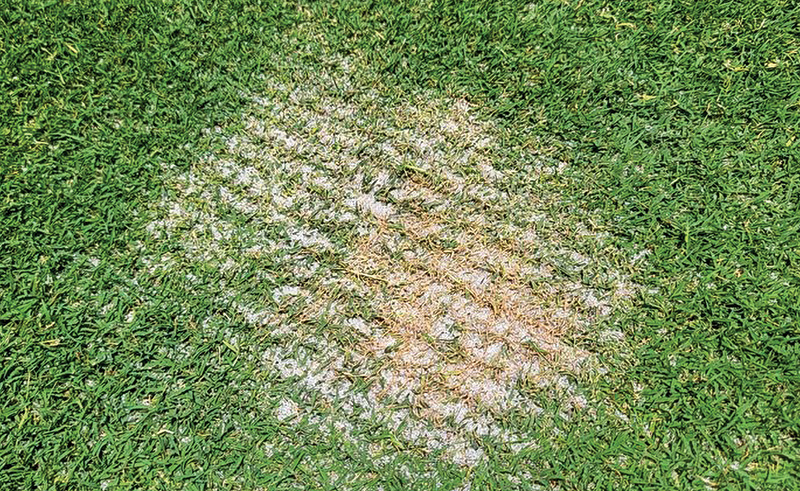
Close up showing selective control of the off-type and living TifEagle underneath.
Sod farms often hire inspectors to walk their fields and mark off-types during the establishment process so they can be removed prior to harvest and help ensure that the customer gets “clean” grass. While certified sources are guaranteed to be genetically correct, it is still recommended that you visit the sod farm at least once prior to harvest so you have done your due diligence and can discuss cultural practices and the application of products (e.g., Lexicon) that can help with the establishment of sprigs and shorten the time needed to open the greens up for play.
Encroachment from the collar can go unnoticed for years, and large portions of a green’s surface can end up being lost before you know it. A reduction of 10 feet or more along the perimeter is not uncommon in older greens that have not been intensively managed. Significant losses can even occur with regular hand picking and mechanical edging of collars, as superintendents of intensively managed greens are still reporting losses due to encroachment of around an inch per year. Severe encroachment can sharpen turns along the cleanup pass, and the increased pressure from mowers can create bare areas and ruts. Damage can become particularly evident when triplex mowers are used instead of walk mowers. Hole locations can be lost when shelves near the edge shrink and there is no longer enough room to place a “good” pin. Greens are typically renovated when their original size and design characteristics have become overly compromised.
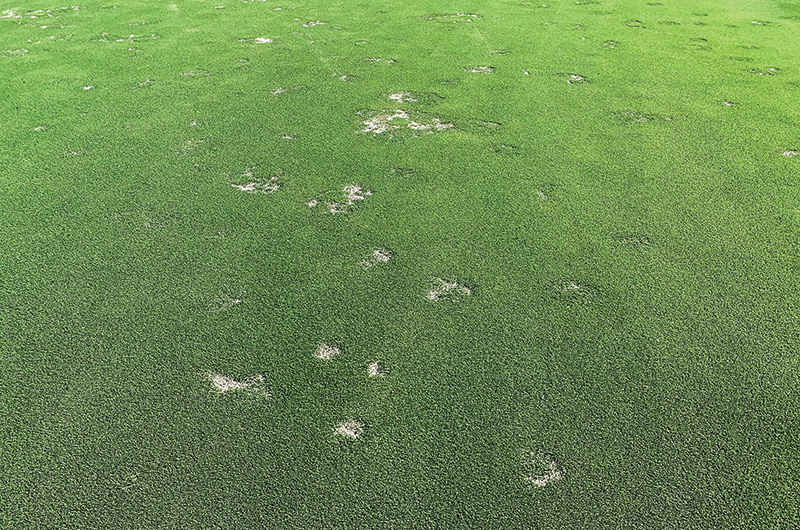
Regular topdressing of treated patches is needed to maintain a level surface until they fill in completely. This is four weeks after a summertime treatment.
If you have ever regrassed fairways or done a no-till renovation on putting greens, you know that complete removal of the existing grass is difficult. Unfortunately, even the best planned and executed renovations can result in a return of unwanted grass. The loss of methyl bromide about 20 years ago has made complete control more difficult and driven university researchers to find other effective methods. The current “standard” practice is currently two or three applications of glyphosate plus fluazifop-p, with some including the soil fumigant dazomet after the last nonselective foliar application. Although near complete control can be obtained with this method when it is performed properly, there is really zero tolerance when changing between warm-season grasses. Complete eradication of the existing grass is not quite as important when putting greens are stripped down past the dark organic zone before regrassing, but there is still a chance that some plant parts may reestablish during the process.
One of the largest causes for regrowth of the existing grass and unwanted off-types is when a calendar-based application interval is used and subsequent nonselective foliar absorbed treatments are made before the grasses have produced enough new green leaf tissue. Waiting for sufficient regrowth, regardless of an anticipated date, is a much better method since foliar applications will not be wasted on dead grass or bare dirt. Starting applications in the fall, and extending them into the spring, during a no-till renovation, may give you the best chance for success since herbicides are typically more effective in the fall, and the extended timeframe will allow for more regrowth to be treated.

All patches were almost completely healed six weeks after treatment.
Overseeding greens after the initial fall applications can provide a high-quality putting surface over the winter, and the cool-season grass will be relatively easy to remove in the spring. I have also seen sprayed-out putting surfaces left unseeded over the winter to produce super-fast greens and avoid the overseeding process, which is costly and time-consuming. Adding a cool-season grass to the greens over the winter can also increase nematode populations and transition problems in the spring, but this can be corrected with proper nematicide applications (Rowland, 2023).
Another cause for unacceptable control of unwanted grasses is the use of “dirty” spray water that binds to glyphosate molecules. These problematic water sources contain high levels of calcium, metal ions and/or organic matter and can cause a large reduction in efficacy. If questionable quality water is the only source available, the addition of sprayable ammonium sulfate (8-17 pounds per 100 gallons) prior to the addition of herbicides is highly recommended. Ammonium sulfate can increase herbicidal activity by ≥20% in cases where water quality is not a major issue and >50% when it is. Another trick used to increase efficacy is by reducing the carrier volume down to around 10 gallons per acre, as this reduces the concentration of cations and contaminants that can bind with glyphosate.
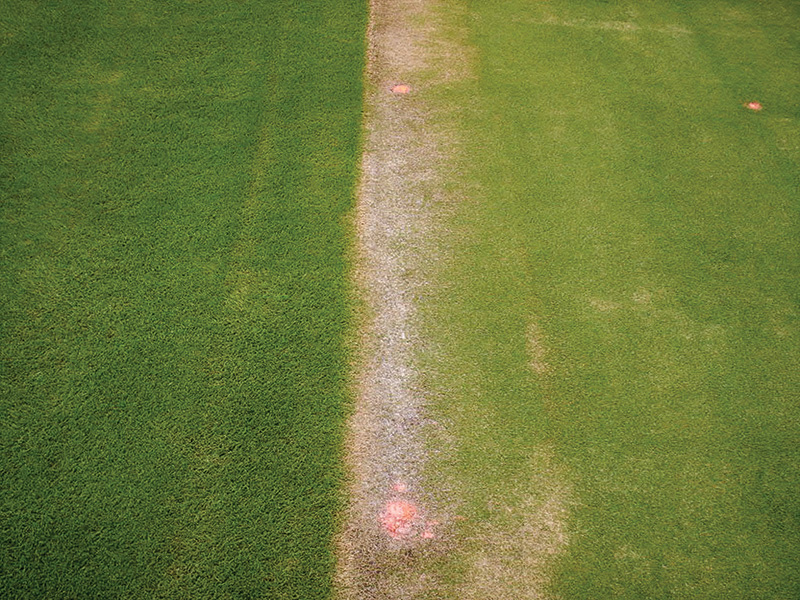
To deal with Tifway encroachment, different peat mixtures (90/10, 80/20, 50/50 and 100%) were used as a protective barrier for the underlying ultradwarf bermudagrass — 90/10 was sufficient.
After greens are planted with your chosen grass variety, rogueing on a frequent basis will help weed out any unusual looking grasses and prevent large patches from forming. If you have been diligent at trying to remove off-types but still find them, it may be beneficial to have the grass genetically tested, although determining which kind of bermudagrass is growing within your newly planted grass can be difficult even when the genotyping-by-sequencing method is used. The older standards Tifgreen and Tifdwarf have a bad reputation for not remaining pure and can sometimes be full of off-types in just a few years. Most mutations found within bermudagrass putting greens have a genetic background that links them to the “standard” grasses. Mutations within the ultradwarf bermudagrass varieties appear to occur less frequently, and many of these greens have gone over 20 years without significant visible changes.
If an unusual-looking grass grows similarly to the base grass, is only visible when observed at a certain angle or time of day and does not grow or scalp excessively, it may be an off-type but should not need to be removed or treated differently. When a grass within a green grows faster than the base grass and scalps excessively, it can cause problems with aesthetics and playability. These spongy patches can sometimes be managed sufficiently by working in a heavy spot topdressing to firm up the surface and limit scalping. Some superintendents have also had success using Anuew to control the growth of these faster-growing off-types.
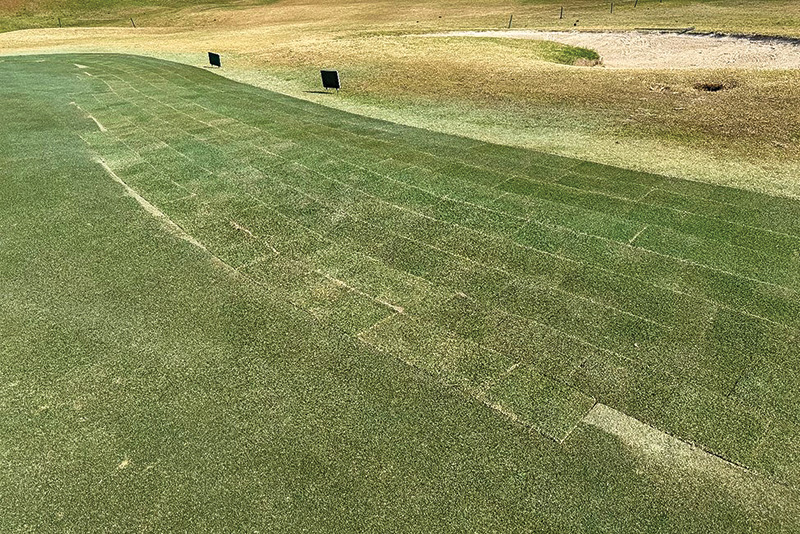
Around 10 feet of this putting green was lost to encroachment and was resodded.
When I was working with the USGA as an agronomist, I came across a case in Florida where the collar grass had been brought deep into the ultradwarf bermudagrass greens by hollow-tine aerification. The redistributed grass had developed into hundreds of patches on each green that ranged in size from a golf ball to a basketball. The managers were worried they would have to regrass their greens due to this unsightly contamination, particularly since they were only 5 years old, and they had a big event coming up. Luckily for them I had developed a process at the University of Florida (FLREC), after a prodding from John Cisar, Ph.D., that selectively controlled faster growing grasses in ultradwarf bermudagrass putting greens. Although it sounded risky to the superintendent at first, he adopted the practice after a description of the protocol and being shown pictures of a successful treatment. They dedicated a small crew to the process and were able to successfully remove the vast majority of patches with only one treatment. Contaminated areas that were less than a foot wide filled in relatively quickly since the base grass was still alive underneath and waiting for a chance to grow back. Larger areas were supplemented with hex plugs from their turf plot after seeing they were slower to fill in. At last check, the treated areas were still clean, and control has lasted for over a year.
If your putting greens are contaminated by a faster-growing grass or even hard-to-control weeds, you can try this protocol:
Test on a turf plot or practice green first to get comfortable with the process and fine-tune things before expanding on to more visible areas.
- Stop applying growth regulators to the area at least a week ahead of time unlessthey do not affect the growth rate of the off-type.
- Do not mow for at least a couple of days prior to treatment to allow the off-type to outgrow the base bermudagrass by >50%.
- Skip mowing the cleanup pass if trying to control collar grass that is encroaching into the green.
- Treat a maximum of 1 foot at a time to make sure there is still viable grass underneath.
- If contamination is away from the edge, the process can be performed after cultural practices when the green already has sand/peat on it and mowing can be skipped for a few days.
- Apply dry topdressing sand that contains peat moss (e.g., 90/10, 80/20) to cover the base grass, but leave the higher growing grass exposed.
- The organic component is key, as glyphosate binds tightly to organic matter, and the peat moss will protect the underlying grass from the herbicide application.
- Straight sand does not work.
- Sometimes a light brooming or dragging will expose the off-type sufficiently, but some touching up by hand may be necessary to provide optimum exposure of the off-type and protection of the base grass.
- Make sure the topdressing mix extends at least 6 inches past the off-type to reduce the possibility of damage from spray drift.
- Spray when wind is calm.
- Mix 1 ounce of glyphosate per gallon of water and apply directly to the faster- growing bermudagrass that is exposed through the protective barrier.
- Spray only until the off-type is wet.
- Do not spray until runoff.
- Be aware that glyphosate can creep beyond the point of contact by an inch or more, so treat edges of the green accordingly.
- Do not use high-pressure sprayers, as they can push the glyphosate past the protective barrier.
- A high-quality handheld sprayer with an adjustable cone nozzle works the best.
- The spray pattern should include droplets large enough to reduce drift but small enough so that they do not penetrate the protective organic barrier.
- Addition of surfactants/penetrants is not recommended, although adding sprayable ammonium sulfate at 21 grams per 1,000 square feet (~2 gallons) may improve control.
- Let the spray dry for at least three hours, or ideally overnight if no rain is forecast and the greens can go without irrigation, and then mow with buckets or sweep the sand up when dry.
- Do not irrigate before removing glyphosate-treated topdressing.
- Rollers and foot traffic can transfer the glyphosate to unprotected grass when wet or covered with dew.
- Dispose of the collected topdressing mix where it will not contact any green plant parts.
- Fertilize and topdress the treated areas regularly after the off-types have been removed to encourage growth of the base grass and keep the surface level.
- It can take as little as two weeks and as long as two months for the areas to fill back in depending on the size of the area treated.
Even though this process may seem complicated and a little scary at first, it is actually simple and safely repeatable, particularly after being performed successfully for the first time.
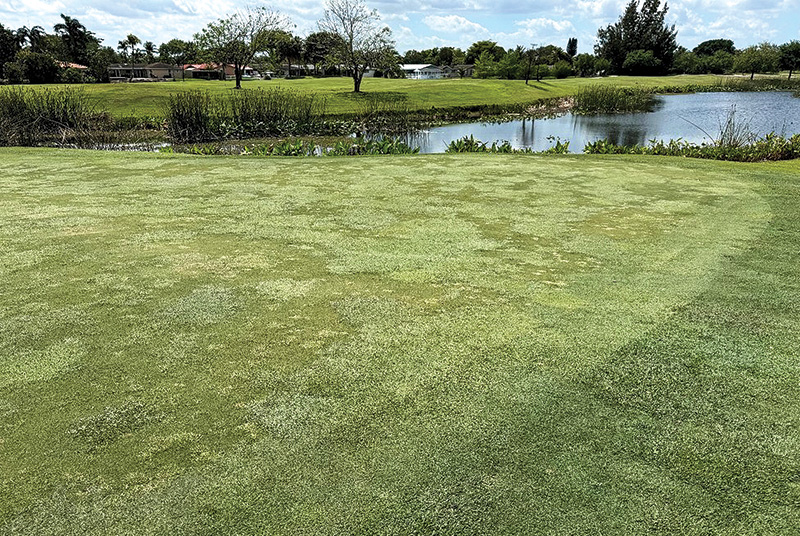
Severe contamination of a bermudagrass putting green. Seashore paspalum and common bermudagrass had almost taken over the entire green. It is too late to do anything but renovate at this point. Stripping off the grass and root zone is highly recommended in this case.
Performing a chemical edging of the collar every summer could help eliminate encroachment and increase a green’s lifespan. This process is easier and more precise when a tracer wire is installed along the original perimeter of the putting green since it can be marked prior to treatment. It also makes it more likely that the base grass will be alive underneath and grow back after being exposed.
Unfortunately, if a green has been overrun with off-types and you can hardly tell if the base grass still exists, it is time to renovate. When regrassing a green, it is best to remove the entire dark organic root zone and replace it with a soil mix like that used during construction so soil layering is minimized, and regrowth of the unwanted grass is less likely. If greenside bunkers are also due to be renovated, you can eliminate the need for replacement sand by removing the grass around the greens and bunkers and regrading the area to match the new lower level of the putting green. Bringing a greens soil profile back to the original depth can also be done at this point.
Hopefully this “new” selective treatment can reduce the amount of work and expense associated with managing the green/collar interface and the removal of unwanted off-types within golf course greens.
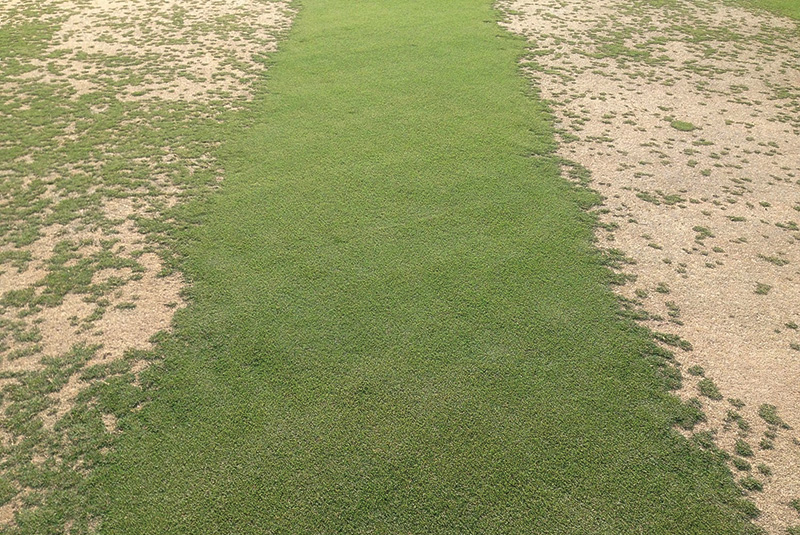
A bermudagrass putting green that had a bad spring transition after overseeding due to increased sting nematode numbers. A nematicide application had been applied in the fall to where the green strip developed in the spring.
References
- Reasor, E., J. Brosnan. 2018. Research update on off-type grasses in ultradwarf bermudagrass putting greens. Golf Course Management 86(6):68-72.
- Reasor, E. 2019. Off-type grasses in ultradwarf bermudagrass greens. Golfdom Online. March 12.
- Rowland, J. 2023. Best management practices for controlling turfgrass nematodes. Green Section Record Online. April 7.
A former USGA agronomist, John Rowland, Ph.D., is the GCSAA Class A lead superintendent for Miami-Dade Parks, Recreation and Open Spaces. He is a 17-year GCSAA member.